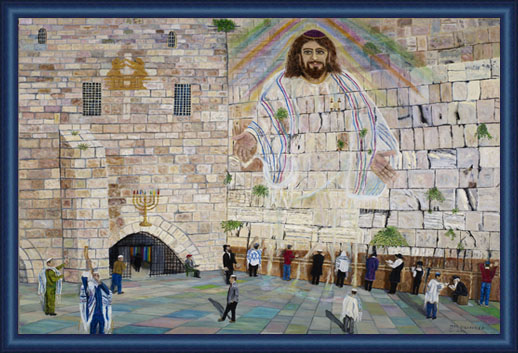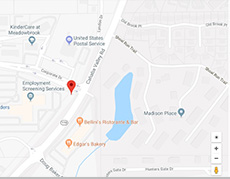Wailing Wall
by Mike DeLorenzo
(12x16)
by Mike DeLorenzo
(12x16)
• Earlier this year I was praying about
my painting assignments for 2011, I heard the Holy Spirit speak to my
heart first the Jews and than the gentiles. I want you to paint the
Middle East first the wailing Wall than the Dome of the Dome of the
Rock.
• I’ve always had a passion for the Jewish people and the Rebirth of not only Israel but of the nation of Judah.
• The day I was going to start to paint the Wailing Wall I ask the Lord for a verse, I felt at that time lead to read Ezra 8-9. But Chapter 9 a couple verses leap out at me.
• Ezra 9:8-9 8 And now for a little while grace has been shown from the LORD our God, to leave us a remnant to escape, and to give us a peg in His holy place, that our God may enlighten our eyes and give us a measure of revival in our bondage. 9 For we were slaves. Yet our God did not forsake us in our bondage; but He extended mercy to us in the sight of the kings of Persia, to revive us, to repair the house of our God, to rebuild its ruins, and to give us a wall in Judah and Jerusalem.
• For years the prayers of the Jews have gone up before the Lord…. Crying out to God day and night.
• One day they will recognize their Messiah.
• I have the Menorah on the wall above the tunnel, it has the 7 colors of the rainbow. God want to give the Jews revelation of who He is. God is light… Revelation’s and Isaiah talk about the 7 spirits of God that come to reveal the nature and character of God,
• Isaiah 11 1And there shall come forth a rod out of the stem of Jesse, and a Branch shall grow out of his roots:
• 2And the spirit of the LORD shall rest upon him, the spirit of wisdom and understanding, the spirit of counsel and might, the spirit of knowledge and of the fear of the LORD;
• Revelation 3:1 "And to the angel of the church in Sardis write, ‘These things says He who has the seven Spirits of God and the seven stars: "I know your works, that you have a name that you are alive, but you are dead. ) • Revelation 4:5 And from the throne proceeded lightnings, thunderings, and voices. Seven lamps of fire were burning before the throne, which are the seven Spirits of God.
• Revelation 5:6 And I looked, and behold, in the midst of the throne and of the four living creatures, and in the midst of the elders, stood a Lamb as though it had been slain, having seven horns and seven eyes, which are the seven Spirits of God sent out into all the earth.
• The ark of the covenant is also on the wall with the cross going through it. May the presence of Yahweh fill Jerusalem and lead are brothers to the cross of the Lord Jesus Christ.
• There are many different people I put praying, but when I speak at your church or in person I will share the rest of the story, to long to write.
• Below is some history of the wailing wall. I have the Torah over the heart of the Lord, because the Lord says I've come to write my word upon your heart. The Western Wall (Ha-Kotel Ha-Ma'aravi) in Jerusalem is the holiest of Jewish sites, sacred because it is a remnant of the Herodian retaining wall that once enclosed and supported the Second Temple. It has also been called the "Wailing Wall" by European observers because for centuries Jews have gathered here to lament the loss of their temple. The Western Wall Plaza, the large open area that faces the Western Wall, functions as an open-air synagogue that can accommodate tens of thousands of worshipers. Prayers take place here day and night, and special services are held here as well. History The Western Wall was built by King Herod in 20 BC during his expansion of the Temple enclosure, and is part of a retaining wall that enclosed the western part of Temple Mount. According to the Roman-Jewish historian Josephus, construction of the walls took 11 years, during which time it rained in Jerusalem only at night so as not to interfere with the workers' progress. In 70 AD, the Romans destroyed Jerusalem and its Temple. During the Ottoman Period (beginning in the 16th century), the wall became the Jews' chief place of pilgrimage, where they came to lament the destruction of the Temple. For centuries, the Western Wall was located in a narrow alley just 12 feet wide that could accommodate only a few hundred densely packed worshipers. But in 1967, immediately after the Six Day War, Israelis leveled the neighboring Arab district to create the Western Wall Plaza, which can accommodate tens of thousands of pilgrims. At the same time, the Israelis made the wall about 6 1/2 feet higher by digging down and exposing two more tiers of ashlars (squared stones) from the Temple Plaza's retaining wall that had been buried by accumulated debris for centuries. What to See The huge, lower stones (ashlars) of the wall are from the time of Herod, while those higher up date from Omayyad and Fatimid times. The sides of the Herodian monumental ashlars have been carved with such precision that they rest perfectly against and on top of each other, without mortar. Over the centuries, the fine straight lines and margins of some of the ashlars have eroded away. At the prayer section of the Western Wall, grass grows out of the upper cracks. The lower cracks of the chalky, yellow-white blocks have been stuffed with bits of paper containing written prayers. Orthodox Jews can be seen standing at the wall, chanting and swaying. Some Jews visit the wall daily to recite the entire Book of Psalms. In addition to the daily and Sabbath prayer services, special events like Bar and Bat Mitzvah are also celebrated at the Western Wall. On Tisha B'Av, which falls in July or August, a fast is held commemorating the destruction of the First and Second Temple, and worshipers sit on the ground reciting the Book of Lamentations and liturgical dirges. Visitors of all religions are welcome to approach the Wall and to pray silently beside it. Men who would like to go to the wall must wear a hat or take a free head covering from a box beside the entrance to the prayer area. Women may also borrow the required shawls and short-skirt coverings. A dividing screen reserves an area at the extreme right of the Western Wall for women, who are not allowed into the men's section in keeping with Orthodox Jewish tradition. In the right hand corner of the Women's Prayer Area, beside a protruding newer building, you can see an area of the Wall composed of small, rough stones. These stones block a fragment of a Herodian era gate to the Temple Mount, today called Barclay’s Gate after the 19th-century American consul who first identified it. To the south of the earthen ramp leading up the Temple Mount, you can see a fragment of large stonework protruding out of the Wall. This is Robinson’s Arch, all that remains of a great stairway, set on arches, that passed over the busy market street at the foot of the Western Wall, and led directly into the Great Stoa on the southern side of Temple Mount. For an idea of how high the original construction was, enter the doorway to the Western Wall Tunnel located between the men’s rest rooms and the public telephones on the plaza’s northern side. Both men and women can enter free upon request (closed Saturday). Enter the dark labyrinth of vaults and chambers, pitfalls (now rendered safe by lamps, grates, and barriers), and passages. Inside, the continuation of the Wall is clearly visible. Shafts have been sunk along the Wall to show its true depth. The arches in this artificial cavern date from various eras, ranging from Herodian (37 BC -70 AD) to Crusader (1100-1244). The platform is behind a prayer room filled with Orthodox worshippers. The prayer room is off-limits to women, except in the viewing area. A special walk into recently excavated tunnels alongside the Western Wall can be arranged by making an appointment with the Western Wall Heritage Foundation (tel. 02/627-1333). Admission is NIS 20 ($4.40); special tours are extra.
• I’ve always had a passion for the Jewish people and the Rebirth of not only Israel but of the nation of Judah.
• The day I was going to start to paint the Wailing Wall I ask the Lord for a verse, I felt at that time lead to read Ezra 8-9. But Chapter 9 a couple verses leap out at me.
• Ezra 9:8-9 8 And now for a little while grace has been shown from the LORD our God, to leave us a remnant to escape, and to give us a peg in His holy place, that our God may enlighten our eyes and give us a measure of revival in our bondage. 9 For we were slaves. Yet our God did not forsake us in our bondage; but He extended mercy to us in the sight of the kings of Persia, to revive us, to repair the house of our God, to rebuild its ruins, and to give us a wall in Judah and Jerusalem.
• For years the prayers of the Jews have gone up before the Lord…. Crying out to God day and night.
• One day they will recognize their Messiah.
• I have the Menorah on the wall above the tunnel, it has the 7 colors of the rainbow. God want to give the Jews revelation of who He is. God is light… Revelation’s and Isaiah talk about the 7 spirits of God that come to reveal the nature and character of God,
• Isaiah 11 1And there shall come forth a rod out of the stem of Jesse, and a Branch shall grow out of his roots:
• 2And the spirit of the LORD shall rest upon him, the spirit of wisdom and understanding, the spirit of counsel and might, the spirit of knowledge and of the fear of the LORD;
• Revelation 3:1 "And to the angel of the church in Sardis write, ‘These things says He who has the seven Spirits of God and the seven stars: "I know your works, that you have a name that you are alive, but you are dead. ) • Revelation 4:5 And from the throne proceeded lightnings, thunderings, and voices. Seven lamps of fire were burning before the throne, which are the seven Spirits of God.
• Revelation 5:6 And I looked, and behold, in the midst of the throne and of the four living creatures, and in the midst of the elders, stood a Lamb as though it had been slain, having seven horns and seven eyes, which are the seven Spirits of God sent out into all the earth.
• The ark of the covenant is also on the wall with the cross going through it. May the presence of Yahweh fill Jerusalem and lead are brothers to the cross of the Lord Jesus Christ.
• There are many different people I put praying, but when I speak at your church or in person I will share the rest of the story, to long to write.
• Below is some history of the wailing wall. I have the Torah over the heart of the Lord, because the Lord says I've come to write my word upon your heart. The Western Wall (Ha-Kotel Ha-Ma'aravi) in Jerusalem is the holiest of Jewish sites, sacred because it is a remnant of the Herodian retaining wall that once enclosed and supported the Second Temple. It has also been called the "Wailing Wall" by European observers because for centuries Jews have gathered here to lament the loss of their temple. The Western Wall Plaza, the large open area that faces the Western Wall, functions as an open-air synagogue that can accommodate tens of thousands of worshipers. Prayers take place here day and night, and special services are held here as well. History The Western Wall was built by King Herod in 20 BC during his expansion of the Temple enclosure, and is part of a retaining wall that enclosed the western part of Temple Mount. According to the Roman-Jewish historian Josephus, construction of the walls took 11 years, during which time it rained in Jerusalem only at night so as not to interfere with the workers' progress. In 70 AD, the Romans destroyed Jerusalem and its Temple. During the Ottoman Period (beginning in the 16th century), the wall became the Jews' chief place of pilgrimage, where they came to lament the destruction of the Temple. For centuries, the Western Wall was located in a narrow alley just 12 feet wide that could accommodate only a few hundred densely packed worshipers. But in 1967, immediately after the Six Day War, Israelis leveled the neighboring Arab district to create the Western Wall Plaza, which can accommodate tens of thousands of pilgrims. At the same time, the Israelis made the wall about 6 1/2 feet higher by digging down and exposing two more tiers of ashlars (squared stones) from the Temple Plaza's retaining wall that had been buried by accumulated debris for centuries. What to See The huge, lower stones (ashlars) of the wall are from the time of Herod, while those higher up date from Omayyad and Fatimid times. The sides of the Herodian monumental ashlars have been carved with such precision that they rest perfectly against and on top of each other, without mortar. Over the centuries, the fine straight lines and margins of some of the ashlars have eroded away. At the prayer section of the Western Wall, grass grows out of the upper cracks. The lower cracks of the chalky, yellow-white blocks have been stuffed with bits of paper containing written prayers. Orthodox Jews can be seen standing at the wall, chanting and swaying. Some Jews visit the wall daily to recite the entire Book of Psalms. In addition to the daily and Sabbath prayer services, special events like Bar and Bat Mitzvah are also celebrated at the Western Wall. On Tisha B'Av, which falls in July or August, a fast is held commemorating the destruction of the First and Second Temple, and worshipers sit on the ground reciting the Book of Lamentations and liturgical dirges. Visitors of all religions are welcome to approach the Wall and to pray silently beside it. Men who would like to go to the wall must wear a hat or take a free head covering from a box beside the entrance to the prayer area. Women may also borrow the required shawls and short-skirt coverings. A dividing screen reserves an area at the extreme right of the Western Wall for women, who are not allowed into the men's section in keeping with Orthodox Jewish tradition. In the right hand corner of the Women's Prayer Area, beside a protruding newer building, you can see an area of the Wall composed of small, rough stones. These stones block a fragment of a Herodian era gate to the Temple Mount, today called Barclay’s Gate after the 19th-century American consul who first identified it. To the south of the earthen ramp leading up the Temple Mount, you can see a fragment of large stonework protruding out of the Wall. This is Robinson’s Arch, all that remains of a great stairway, set on arches, that passed over the busy market street at the foot of the Western Wall, and led directly into the Great Stoa on the southern side of Temple Mount. For an idea of how high the original construction was, enter the doorway to the Western Wall Tunnel located between the men’s rest rooms and the public telephones on the plaza’s northern side. Both men and women can enter free upon request (closed Saturday). Enter the dark labyrinth of vaults and chambers, pitfalls (now rendered safe by lamps, grates, and barriers), and passages. Inside, the continuation of the Wall is clearly visible. Shafts have been sunk along the Wall to show its true depth. The arches in this artificial cavern date from various eras, ranging from Herodian (37 BC -70 AD) to Crusader (1100-1244). The platform is behind a prayer room filled with Orthodox worshippers. The prayer room is off-limits to women, except in the viewing area. A special walk into recently excavated tunnels alongside the Western Wall can be arranged by making an appointment with the Western Wall Heritage Foundation (tel. 02/627-1333). Admission is NIS 20 ($4.40); special tours are extra.
 My Mission and the Mike DeLorenzo Art Gallery is to inspire and to share the revelational aspect of art in God's coming Kingdom.
My Mission and the Mike DeLorenzo Art Gallery is to inspire and to share the revelational aspect of art in God's coming Kingdom.
I am inspired to paint this art which gives insight into the heart and mind of our Lord and Savior.
Product Details
Weight: 6 lbs.



